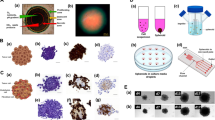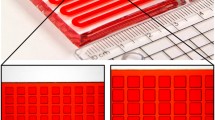Abstract
Due to its similarity to in vivo conditions, tumor spheroids are actively used in research areas, such as drug screening and cell–cell interactions. A substantial quantity of spheroids is crucial for obtaining dependable results in high-throughput screening. Conventional fabrication methods of spheroid have limitations in low yield and morphological variation. Droplet-based microfluidic system capable of mass-producing uniformed spheroids can overcome these limitations. In this study, we investigated the optimal culture conditions, which allows to researchers provide guidelines for producing spheroids with the desired diameter and quantity. Mass-produced spheroids were employed to analyze compaction, which is crucial for evaluating the remission effects of drugs, as well as the formation of a necrotic core, which induces a bias in the analysis of drug response and viability. The time point at which compaction is completed and the diameter begins to increase was measured using spheroids with diameters of both > 400 μm and < 400 μm, and spheroids do not proliferate a linear growth trend. Spheroid with diameters ranging from 73.4 ± 11.42 μm to 371 ± 5.11 μm was used to predict the formation of the necrotic core based on live cell counting, and diameter of 300–330 μm was mathematically calculated as the diameter where a necrotic core forms. Additionally, the use of artificial intelligence (AI) for high-throughput analysis is crucial for obtaining time-saving and reproducible data. We produced BT474 and MCF-7 spheroids with diameters of 100, 200, and 300 μm and obtained morphological indicators from an AI-based program to compare the differences in heterogeneous breast tumor spheroids. Through this study, we optimized the diameter of spheroids and the initiation timing for drug screening and emphasized the importance of AI-based morphological analysis in high-throughput screening.





Similar content being viewed by others
Data availability
Data will be made available on request.
References
Imamura, Y., Mukohara, T., Shimono, Y., Funakoshi, Y., Chayahara, N., Toyoda, M., Kiyota, N., Takao, S., Kono, S., Nakatsura, T.: Comparison of 2D-and 3D-culture models as drug-testing platforms in breast cancer. Oncol. Rep. 33, 1837–1843 (2015)
Kapałczyńska, M., Kolenda, T., Przybyła, W., Zajączkowska, M., Teresiak, A., Filas, V., Ibbs, M., Bliźniak, R., Łuczewski, Ł, Lamperska, K.: 2D and 3D cell cultures–a comparison of different types of cancer cell cultures. Arch. Med. Sci. 14, 910–919 (2018)
Choi, N.Y., Lee, M.-Y., Jeong, S.: Recent advances in 3D-cultured brain tissue models derived from human iPSCs. Biochip J. 16, 246–254 (2022)
Ravi, M., Paramesh, V., Kaviya, S., Anuradha, E., Solomon, F.P.: 3D cell culture systems: advantages and applications. J. Cell. Physiol. 230, 16–26 (2015)
Białkowska, K., Komorowski, P., Bryszewska, M., Miłowska, K.: Spheroids as a type of three-dimensional cell cultures—examples of methods of preparation and the most important application. Int. J. Mol. Sci. 21, 6225 (2020)
Kimlin, L.C., Casagrande, G., Virador, V.M.: In vitro three-dimensional (3D) models in cancer research: an update. Mol. Carcinog. 52, 167–182 (2013)
Yeon, J.H., Chung, S.H., Baek, C., Hwang, H., Min, J.: A simple pipetting-based method for encapsulating live cells into multi-layered hydrogel droplets. Biochip J. 12, 184–192 (2018)
Kang, S.-M.: Recent advances in microfluidic-based microphysiological systems. Biochip J. 16, 13–26 (2022)
Driver, R., Mishra, S.: Organ-on-a-chip technology: an in-depth review of recent advancements and future of whole body-on-chip. Biochip J. 17, 1–23 (2023)
Jang, M., Kim, H.N.: From single-to multi-organ-on-a-chip system for studying metabolic diseases. Biochip J. (2023). https://doi.org/10.1007/s13206-023-00098-z
Foty, R.: A simple hanging drop cell culture protocol for generation of 3D spheroids. JoVE J. Vis. Exp. (2011). https://doi.org/10.3791/2720-v
Kloß, D., Fischer, M., Rothermel, A., Simon, J.C., Robitzki, A.A.: Drug testing on 3D in vitro tissues trapped on a microcavity chip. Lab Chip 8, 879–884 (2008)
Jung, Y.H., Park, K., Kim, M., Oh, H., Choi, D.-H., Ahn, J., Lee, S.-B., Na, K., Min, B.S., Kim, J.-A.: Development of an extracellular matrix plate for drug screening using patient-derived tumor organoids. Biochip J. (2023). https://doi.org/10.1007/s13206-023-00099-y
Kochanek, S.J., Close, D.A., Johnston, P.A.: High content screening characterization of head and neck squamous cell carcinoma multicellular tumor spheroid cultures generated in 384-well ultra-low attachment plates to screen for better cancer drug leads. Assay Drug Dev. Technol. 17, 17–36 (2019)
Kwak, B., Lee, Y., Lee, J., Lee, S., Lim, J.: Mass fabrication of uniform sized 3D tumor spheroid using high-throughput microfluidic system. J. Control. Release 275, 201–207 (2018)
Park, S.Y., Hong, H.J., Lee, H.J.: Fabrication of cell spheroids for 3D cell culture and biomedical applications. Biochip J. 17, 24–43 (2023)
Moriconi, C., Palmieri, V., Di Santo, R., Tornillo, G., Papi, M., Pilkington, G., De Spirito, M., Gumbleton, M.: INSIDIA: a FIJI macro delivering high-throughput and high-content spheroid invasion analysis. Biotechnol. J. 12, 1700140 (2017)
Zanoni, M., Piccinini, F., Arienti, C., Zamagni, A., Santi, S., Polico, R., Bevilacqua, A., Tesei, A.: 3D tumor spheroid models for in vitro therapeutic screening: a systematic approach to enhance the biological relevance of data obtained. Sci. Rep. 6, 19103 (2016)
Bédard, P., Gauvin, S., Ferland, K., Caneparo, C., Pellerin, È., Chabaud, S., Bolduc, S.: Innovative human three-dimensional tissue-engineered models as an alternative to animal testing. Bioengineering 7, 115 (2020)
Piccinini, F.: AnaSP: a software suite for automatic image analysis of multicellular spheroids. Comput. Methods Programs Biomed. 119, 43–52 (2015)
Piccinini, F., Peirsman, A., Stellato, M., Pyun, J.-C., Tumedei, M.M., Tazzari, M., Wever, O.D., Tesei, A., Martinelli, G., Castellani, G.: Deep learning-based tool for morphotypic analysis of 3D multicellular spheroids. J. Mech. Med. Biol. 23, 2340034 (2023)
Piccinini, F., Tesei, A., Arienti, C., Bevilacqua, A.: Cancer multicellular spheroids: volume assessment from a single 2D projection. Comput. Methods Programs Biomed. 118, 95–106 (2015)
Mishra, A., Kai, R., Atkuru, S., Dai, Y., Piccinini, F., Preshaw, P.M., Sriram, G.: Fluid flow-induced modulation of viability and osteodifferentiation of periodontal ligament stem cell spheroids-on-chip. Biomater. Sci. 11, 7432–7444 (2023)
Diosdi, A., Hirling, D., Kovacs, M., Toth, T., Harmati, M., Koos, K., Buzas, K., Piccinini, F., Horvath, P.: Cell lines and clearing approaches: a single-cell level 3D light-sheet fluorescence microscopy dataset of multicellular spheroids. Data Brief 36, 107090 (2021)
Koike, C., McKee, T., Pluen, A., Ramanujan, S., Burton, K., Munn, L., Boucher, Y., Jain, R.: Solid stress facilitates spheroid formation: potential involvement of hyaluronan. Br. J. Cancer 86, 947–953 (2002)
Pinto, B., Henriques, A.C., Silva, P.M., Bousbaa, H.: Three-dimensional spheroids as in vitro preclinical models for cancer research. Pharmaceutics 12, 1186 (2020)
Nath, S., Devi, G.R.: Three-dimensional culture systems in cancer research: focus on tumor spheroid model. Pharmacol. Ther. 163, 94–108 (2016)
Lin, R.Z., Chang, H.Y.: Recent advances in three-dimensional multicellular spheroid culture for biomedical research. Biotechnol. J. Healthc. Nutr. Technol. 3, 1172–1184 (2008)
Lin, R.-Z., Chou, L.-F., Chien, C.-C.M., Chang, H.-Y.: Dynamic analysis of hepatoma spheroid formation: roles of E-cadherin and β1-integrin. Cell Tissue Res. 324, 411–422 (2006)
Ferrante, A., Rainaldi, G., Indovina, P., Indovina, P.L., Santini, M.T.: Increased cell compaction can augment the resistance of HT-29 human colon adenocarcinoma spheroids to ionizing radiation. Int. J. Oncol. 28, 111–118 (2006)
Däster, S., Amatruda, N., Calabrese, D., Ivanek, R., Turrini, E., Droeser, R.A., Zajac, P., Fimognari, C., Spagnoli, G.C., Iezzi, G.: Induction of hypoxia and necrosis in multicellular tumor spheroids is associated with resistance to chemotherapy treatment. Oncotarget 8, 1725 (2017)
Kim, C.: Droplet-based microfluidics for making uniform-sized cellular spheroids in alginate beads with the regulation of encapsulated cell number. Biochip J. 9, 105–113 (2015)
Aguilar Cosme, J.R., Gagui, D.C., Bryant, H.E., Claeyssens, F.: Morphological response in cancer spheroids for screening photodynamic therapy parameters. Front. Mol. Biosci. 8, 784962 (2021)
Shirai, K., Kato, H., Imai, Y., Shibuta, M., Kanie, K., Kato, R.: The importance of scoring recognition fitness in spheroid morphological analysis for robust label-free quality evaluation. Regen. Ther. 14, 205–214 (2020)
Zhu, J., Thompson, C.B.: Metabolic regulation of cell growth and proliferation. Nat. Rev. Mol. Cell Biol. 20, 436–450 (2019)
Han, S.J., Kwon, S., Kim, K.S.: Challenges of applying multicellular tumor spheroids in preclinical phase. Cancer Cell Int. 21, 1–19 (2021)
Acknowledgements
This study was supported by the National Research Foundation of Korea (NRF) grant funded by the Korean government (MEST) (NRF-2022R1A2C2003103, NRF-2021R1A2C3011254, and NRF-2020R1A5A1018052). F.P., and G.C. acknowledge support from the MAECI Science and Technology Cooperation Italy–South Korea Grant Years 2023–2025 by the Italian Ministry of Foreign Affairs and International Cooperation (CUP project: J53C23000300003).
Author information
Authors and Affiliations
Corresponding author
Ethics declarations
Conflict of Interest
The authors declare that they have no conflict of interest.
Additional information
Publisher's Note
Springer Nature remains neutral with regard to jurisdictional claims in published maps and institutional affiliations.
Supplementary Information
Below is the link to the electronic supplementary material.
Rights and permissions
Springer Nature or its licensor (e.g. a society or other partner) holds exclusive rights to this article under a publishing agreement with the author(s) or other rightsholder(s); author self-archiving of the accepted manuscript version of this article is solely governed by the terms of such publishing agreement and applicable law.
About this article
Cite this article
Lee, J., Kim, Y., Lim, J. et al. Optimization of Tumor Spheroid Preparation and Morphological Analysis for Drug Evaluation. BioChip J 18, 160–169 (2024). https://doi.org/10.1007/s13206-024-00143-5
Received:
Revised:
Accepted:
Published:
Issue Date:
DOI: https://doi.org/10.1007/s13206-024-00143-5




